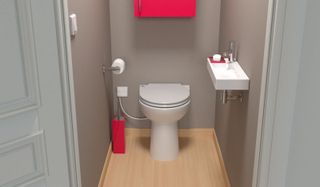What is a macerator toilet and are they a good option for your project?
Macerator toilets can be a solution when you don't have the required "fall" for a soil pipe to install a regular toilet. Here we look at how they work and whether they are a good idea

If you are thinking of installing a new bathroom in a space with no existing sewage outlet, such as a basement or attic, you may have wondered ‘what is a macerator toilet?’
A macerating toilet – also known as an up-flush toilet – works by breaking down waste and toilet paper so that it can be easily transported through smaller pipes when use of a main stack is not an option.
A macerator toilet is one of manytypes of toiletthat can be installed to meet different requirements and specifications. The above pictured example is Saniflo's Sanicompact macerator toilet which comes with an inbuilt macerator andis available for £663.31 from City Plumbing.
What is a macerator toilet and how does it work?
When the toilet is flushed, the waste travels to the macerator system, which automatically turns on, and rotating blades mix the waste with more water to form a thinner slurry.
Once the waste is turned into slurry, it is pumped upwards through a piping system to your existing main plumbing stack, a pipe which directs wastewater from all the fixtures in your home to a municipal or private sewer system.
Building expert Tobias Roberts, of sustainable product specialistRise, says it is essential to state that macerating toilets look just like any ceramic bowl you usually have in your bathroom and still allow you to push the lever or button on the toilet to simply flush away your waste – so yourdownstairs toilet ideaswill not need a complete rethink.

Where does the waste go from a macerator toilet?
Property expert Paul Gibbens, ofhousebuyers4u, said: “After the waste and toilet paper are ground into a slurry by the macerator pump, the waste is then pumped out to a remote drain, sewer, or septic system.
“This can be either a main sewer line, a septic tank, or a soil stack, depending on the setup of the building.
“The ability to pump the waste allows for flexibility in where the toilet can be located, as it doesn't rely solely on gravity to move the waste.”
What are the advantages of a macerator toilet?
Paul says macerator toilets can be installed in places where traditional toilets can often not be installed, such as basements, attics, or additions to a home.
他们不需要分手地板安装l new drain lines and there is also no need for major plumbing worksince they can pump waste against gravity, so there's no need to install plumbing that relies on a downward slope.
Some models are compact and can be installed in tight spaces or unconventional areas and they can be used in temporary setups like construction sites, events, or mobile homes.
Paul adds: “For home renovations or additions, using a macerator toilet can sometimes be more cost-effective than redoing the entire plumbing system.”
The grinding process can also lead to a more homogenised waste, which might be easier to treat in certain wastewater systems.
Get the Homebuilding & Renovating Newsletter
Bring your dream home to life with expert advice, how-to guides and design inspiration, direct to your inbox.
Sam is based in Coventry and has been a news reporter for nearly 20 years. His work has featured in the Mirror, The Sun, MailOnline, the Independent, and news outlets throughout the world. As a copywriter, he has written for clients as diverse as Saint-Gobain, Michelin, Halfords Autocentre, Great British Heating, and Irwin Industrial Tools. During the pandemic, he converted a van into a mini-camper and is currently planning to convert his shed into an office and Star Wars shrine.
Bring your dream home to life with expert advice, how-to guides and design inspiration, direct to your inbox.
Thank you for signing up to Homebuilding. You will receive a verification email shortly.
There was a problem. Please refresh the page and try again.

